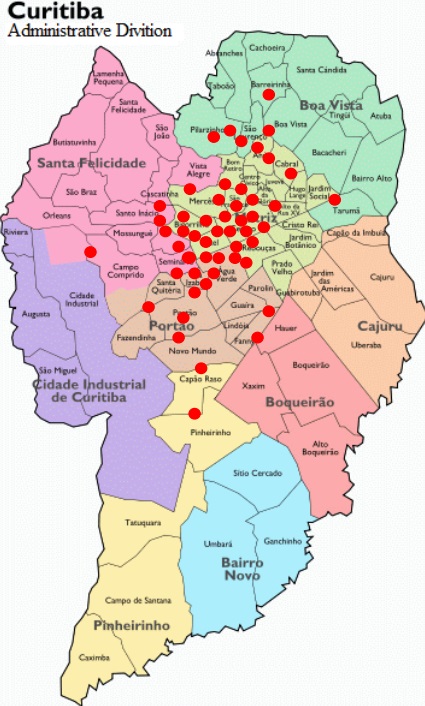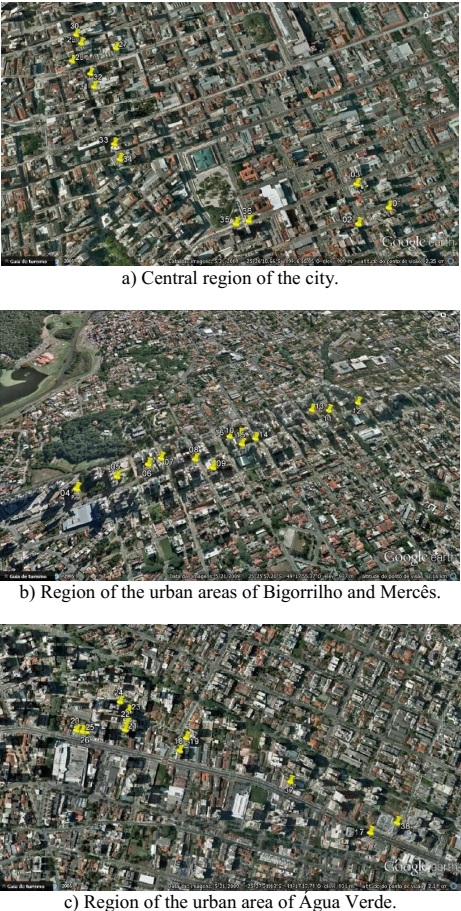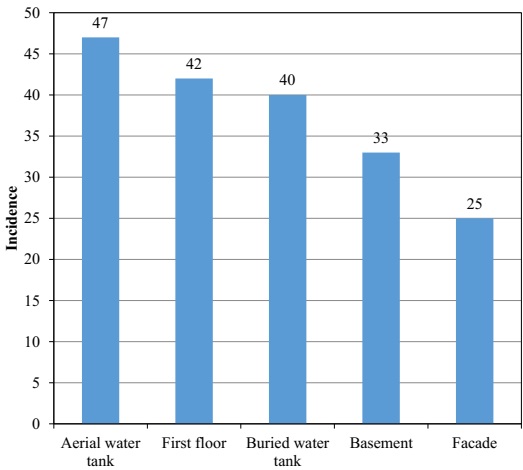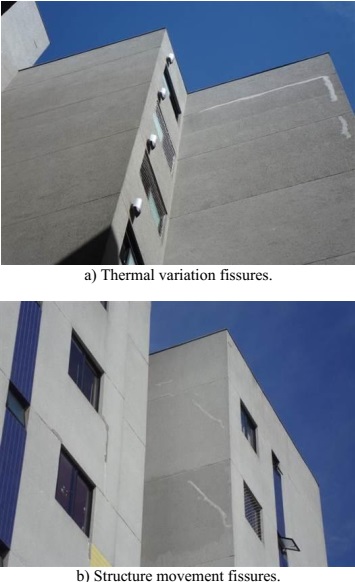Services on Demand
Journal
Article
Indicators
-
 Cited by SciELO
Cited by SciELO -
 Access statistics
Access statistics
Related links
-
 Similars in
SciELO
Similars in
SciELO
Share
Revista ALCONPAT
On-line version ISSN 2007-6835
Rev. ALCONPAT vol.6 n.2 Mérida May./Aug. 2016
https://doi.org/10.21041/ra.v6i2.135
Study case
Evaluation of pathological manifestations in buildings in terms of geographical orientation
1 Professor do Departamento Acadêmico de Construcción Civil da UTFPR - Campus Curitiba, Brasil.
2 Arquiteta da Estruktor Patologia das Construcciones, Brasil.
3 Tecnóloga em Concreto, Brasil.
4 Tecnóloga em Concreto da Estruktor Patologia das Construcciones, Brasil.
In order to evaluate the incidence of pathological manifestations on the facades of buildings, correlated with the geographical location, 52 buildings for residential and commercial use were analyzed in this study; these were distributed in different parts of the city of Curitiba, Brazil. It was observed that all the buildings evaluated had some type of pathological manifestation, and 25 of these were present on the facades of the buildings. It was found that the pathological manifestations on the facades show up in different amounts and locations, having identified a relation with the variation of temperature and the direction of the wind in terms of geographical orientation.
Keywords: durability; facade; geographical location; pathological manifestation
Con el propósito de evaluar la incidencia de manifestaciones patológicas en fachadas de edificios, correlacionadas con la dirección geográfica, se analizaron en este estudio 52 edificios de uso residencial y comercial distribuidos en varias partes de la ciudad de Curitiba - Brasil. Se observó que todos los edificios evaluados tuvieron algún tipo de manifestación patológica, y 25 de éstas en las fachadas. Se encontró que las manifestaciones patológicas en fachadas aparecen en diferentes cantidades y direcciones, habiéndose identificado una relación con la variación de la temperatura y la dirección del viento en función de la orientación geográfica.
Palabras clave: durabilidad; fachada; dirección geográfica; manifestación patológica
Com a finalidade de avaliar a incidência de manifestações patológicas em fachadas de edifícios, correlacionando com as direções geográficas, neste trabalho foram analisados 52 edifícios de uso residencial e comercial distribuídos em diversas regiões da cidade de Curitiba - Brasil. Foi observado que todos os edifícios vistoriados apresentaram algum tipo de manifestação patológica, sendo que 25 apresentaram problemas nas fachadas. Verificou-se que as manifestações patológicas nas fachadas aparecem em quantidades diferentes nas diferentes direções, tendo sido identificada uma relação com a variação de temperatura e com a direção dos ventos, conforme a direção geográfica.
Palavras chave: durabilidade; fachadas; direção geográfica; manifestações patológicas
1. Introduction
Civil construction interacts with the occurrence of pathological manifestations in its projects, which is due to a variety of reasons. According to the Evaluation method indicated by the ASTM E632-82 (1996), which analyzes the durability of the constructions, there are different factors that influence the buildings and which can be divided in five different groups, according to their nature: atmospheric, biological, load, incompatibility, and use factors, as can be seen in Figure 1.
The atmospheric factors are defined as the group of factors associated to the environment, which include the temperature, solar radiation, air pollutants, and the humidity caused by rain, snow or ice. Such factors always act on the edifications and could present a series of variations with regard to the seasons of the year and the geographical location of the development. The variation of the temperature can cause a dimensional variation on the material (dilation or contraction) (Resende, Barros and Campos, 2001).
The biological agents are characterized mainly by mushrooms or small types of vegetation that need special conditions to develop, such as: temperatures between 10°C and 35°C, elevated relative humidity, the presence of nitrogen, phosphorus, carbon and in less amounts, iron, calcium, chlorine, magnesium, among other chemical components (Shirakawa, 1995). This confirms that the presence of water, in any state, is fundamental for the development of these organisms and makes the facades of building as one of the most ideal locations for their emergence.
The load factors can be represented by the physical action of rain and wind on the facade of the buildings. The incompatibility factors can present themselves due to a type of chemical or physical divergence; the chemistry may happen due to differences in the chemical composition of base and coating materials, or due to the erroneous addition of a material such as gypsum in the mortar and the physics when a coating provides unsustainable loads to the base or substrate, causing displacements.
Finally, the factors of use are determined by the direct influence of the users of the edification on the materials that comprise the building during the entire useful life of the project, execution, use, operation, and maintenance. (Resende, Barros and Campos, 2001).
According to Barros and Sabbatini (2001), the most frequent pathological problems are: the formation of humidity stains, with the development of mold, splintering and displacement between layers of frieze and the gypsum, and the formation of fissures and cracks.
One of the widely researched factors is the atmospheric action on the facades. Romero et al. (2011) studied the Torre Colpatria, in Colombia, and observed the existence of cracking, carbonation, and the attack of sulphates on the facades of the building being studied, relating the damages observed to factors such as the height at which the damage happened, the geographical orientation of the facade, and the predominant direction of the wind and rain. Lembo (2011) studied three building in the region of the Basilicata, where he verified the influence of the relief around the construction and the predominant direction of the wind, having confirmed, mainly, problems of infiltration and ventilation.
Melo and Carasek (2014) verified the existence of a relation between the predominant direction of the rain and the stains that showed on the facade of historical buildings. The authors also verified the existence of stains due to microbiological action, influenced by solar radiation.
Among the different pathological manifestations found on the facades of buildings, Galletto and Andrello (2013) observed that the main incidences are fissures, followed by stains and the separation of the ceramic coatings, both in new and old buildings. The authors believe that the fissures that are present in the system of joints, caused by thermal and humidity variations, could have had an influence on the emergence of the other damages. These same damages were observed by Abreu et al. (2013), who studied facades that were coated with ceramic elements and paint.
The splintering of the coatings was studied by Japiassú et al. (2014), who analyzed the interface between mortar and ceramic on the facades of buildings from the 19th and 20th centuries. They confirmed that the adherence between these materials directly influences the splintering of these, having a great relation between the diameter of the aggregates and the ceramic pieces.
Several authors (Melo and Carasek, 2014; Galletto and Andrello, 2013) verified the influence of some environmental parameters such a solar radiation, the direction of rain, thermal and humidity variations on the incidence of pathological manifestations, as these factors may vary in intensity according to the geographical location of the facade of a building, generating a greater incidence of damage on some facades.
In this context, the objective of this work is to verify the main pathological manifestations on facades of residential and commercial buildings on Curitiba/Paraná and to correlate them with their geographical location.
2. Methodological procedures
The development of this research took place in the city of Curitiba, situated on the first plateau of the state of Paraná, at an approximate altitude of 950 m and at 100 km from the coast, and was divided in two stages. The first stage comprised a sample of 52 buildings from the city with locations that are indicated in Figure 2, with ages between 1 and 50 years of construction. The height of the buildings varied between 4 and 23 floors, understanding that 31 of the buildings have 1 basement, 5 have 2 basements, and the other 16 do not have basements. The buildings are mostly located on the central region of the city and in urban developments, where there is a high concentration of buildings.
The evaluation of all the buildings used in this research was due to the wish of a company that specializes in the elaboration of inspection reports. In this stage, the main existing pathological manifestations in the buildings were identified. The inspections were carried out in the common areas of the buildings, notably in the basements, first floor, water tanks, roofs, and on the four facades of each building. Visual inspections were done in the common areas, with photographic records and the measurements of the thickness of the cracks; on the facades, a visual inspection was done, using preemption techniques on the critical regions with safety covers or slings to be able to go around the facade, detecting cracks, coating displacements, efflorescence, and filtrations.
In the second stage, the 25 facades of the buildings of the initial sample that presented pathological manifestations were inspected, relating the facades of the buildings with the geographical position in order to verify if there was any relation between the pathological manifestations and the geographical position. These 25 buildings have heights that vary from 9 to 22 floors. The buildings that do not have problems on the facades were ruled out during this stage. The regions used in the second stage of the investigations are indicated in Figure 3, where the buildings that do present failures on their facades are located.
From the data observed in the inspections of the buildings, the objective was to verify the greater incidences of anomalies and the possibility to associate the pathological manifestations of the facades of the buildings with the geographical location.
3. Results and analysis
In the 52 buildings initially inspected, according to the abovementioned procedures, the main pathological manifestations observed are indicated in Figure 4:
With an incidence of 100% on the condominiums inspected, the corrosion of the frame is the pathological manifestation of higher frequency in terms of having several causative agents, such as filtrations, a lack of coating on the frame, exposure to environments heavy in chlorides (water tanks), among other causes. The second anomaly with higher incidence were the fissures, which also represent a manifestation that is caused by different factors such as: thermal dilation, lack of supports, lintels or beams, caused by corrosion, among others. After fissures, the third anomaly with greater incidence is filtration, followed by the efflorescence and carbonation of the structures. From the failures that were analyzed, the ones with a greater incidence are those that exist on the facades of the buildings, such as the loss of paint, generally considered as splintering.
In Figure 5, it is possible to verify the incidence of anomalies related to the constructive region of the building and that, in this case, anomalies on the facade of approximatery 50% of the buildings evaluated were observed, indicating that it is not only splintering that is related to this problem, as can be seen below:
It can be observed in Figure 5 that the facades of the buildings have a lower incidence of pathological manifestations, occurring in 48% of the buildings that were inspected, that is, in 25 buildings. Despite the lower incidence, the pathological manifestations may be observed on the facades and they are presented in Table 1.
Table 1 Incidence of pathological manifestations on facades.
| Pathological manifestation | Number of incidents on the facade |
|---|---|
| Fissures | 25 |
| Efflorescence | 14 |
| Splintering | 22 |
| Filtrations | 7 |
The incidence percentages of pathological manifestations on the facades of the buildings that were inspected are presented in Table 2, divided according to the geographical location in which they were observed.
Table 2 Incidence percentages of manifestations in each geographical location.
| Geographical Location | Fissures | Efflorescence | Splintering | Filtrations |
|---|---|---|---|---|
| North | 40.0 | 28.6 | 31.8 | 0.0 |
| South | 16.0 | 14.3 | 22.7 | 14.3 |
| East | 16.0 | 28.6 | 18.2 | 57.1 |
| West | 28.0 | 28.6 | 27.3 | 28.6 |
In Table 1 we can appreciate that in all buildings that presented pathological manifestations on their facades, the incidence of fissures was also present; it was seen that the largest portion of the fissures, as indicated in Table 2, happen on the facades that face North, which, in Curitiba, receives the most solar incidence, and which can suffer a variation in temperature of up to 10°C in the same day, as indicated in Figure 7. Some examples of these incidences are shown in Figure 6. Most of the time, splintering also occurs in the same facades as the variation in temperature, in addition to failures in the execution of the building, also have an influence on this type of damage.
The efflorescence presented in 56% of the buildings with pathological manifestations in the facades, appear in less amounts in the southern region, which possesses a lower incidence of wind and rain. In the other geographical regions, the percentage of incidences was the same making it impossible to establish a correlation between this manifestation and the geographical location.
The filtrations, which are present in 28% of the buildings, appear in lower amounts on the east face of the buildings, which is a direction with a great incidence of wind and rain. In Figure 8, we show a map of the predominant direction of the winds in the region, showing that the East region is the one with the most incidences, conducting the rain to this direction as well and thus justifying the higher incidence of filtrations in this region.
In Figure 7, the numbering from 6 to 18 represents the hours of the day in which the solar incidence occurs on a facade that faces North, and the data is sometimes from random days chosen to be cited on the solar chart. For example, in Figure 6a, we can observe that the temperature at 6:00h in the morning of december 22nd appears to be between 14°C and 20°C and at 13:00h, the temperature is above 25°C. In Figure 8, the speed and percentage of incidences of the wind in the different geographical directions and seasons of the year are indicated.
From the flaws observed on the buildings, the ones that stand out the most are the corrosion of the frames that appeared in 100% of the buildings analyzed and the fissures that are also present in 100% of the buildings that have this problem on their facades.
4. Conclusions
From the 52 cases that were analyzed, it was observed that the main pathological manifestations were corrosion on the frames and fissures on all of them, in addition to filtrations in 98% of the buildings, efflorescence in 83%, and carbonation in 81%. The loss of paint and splintering on the facades appeared with a lower incidence of 25% and 17%, respectively.
Pathological manifestations on facades show up on 25 of the 52 buildings that were inspected, observing fissures on 25 of the facades, a loss of paint or splintering on 22 facades, efflorescence on 14, and filtrations on 7 facades of the buildings.
The geographical location with the highest solar incidence presented the most pathological manifestations, with fissures and splintering as the most common; this indicates a probable relation between this geographical location and the types of damages.
The greatest presence of filtrations is seen on the facades that face towards the geographical direction with a higher wind speed and incidence, indicating a probable relation between these factors and the incidence of filtrations.
In spite of the existing indications between the geographical locations and the incidence of pathological manifestations, it is necessary to consider the environmental factors such as solar incidence, variations in temperature, and the predominant directions of the wind and rain in order to establish correlations between geographical location and pathological manifestations.
5. Acknowledgements
The authors would like to thank the Estruktor Patología das Construcciones Ltda company for carrying out the inspections and providing the information necessary for the elaboration of this study.
REFERENCES
Abreu, D. W. M., Lins, A. M. T., Silva, M. S., Farias, M. B. S. (2013), “Patologias no revestimento de fachadas dos edifícios históricos da cidade de Campina Grande”, In: 5º. EnPAC, Campina Grande (PB). [ Links ]
American Society for Testing and Materials. ASTM - E 632-81. Standard recommended practice for developing short-term accelerated test for prediction of the service life of building components and materials, Philadelphia, 1996. [ Links ]
Antunes, G. R. (2010), “Estudo de manifestações patológicas de fachadas em Brasília - Sistematização da incidência de casos”, Dissertação de mestrado. UNB. [ Links ]
Barros, M. M. S. B.; Sabbatini, F. H. (2001), “Produção de revestimentos cerâmicos para paredes de vedação em alvenaria: Diretrizes básicas”, (São Paulo, Brasil: EPUSP). [ Links ]
Galletto, A., Andrello, J. M. (2013), “Patologia em fachadas com revestimentos cerâmicos”, In: CINPAR - IX Congresso Internacional sobre patología y recuperación de estruturas, João Pessoa (Brasil). [ Links ]
Japiassú, J., Carasek, H., Cascudo, O., Velosa, A. L. (2014), “Caracterização da interface azulejo/argamassa de fachadas históricas”, Revista ALCONPAT, V. 4, No. 1, pp. 55-76. [ Links ]
Lembo, F. (2011), “Pathologies of industrialized building made by bearing precast concrete panels. The case study of intervention with the same building system at Chiaromonte, Francavilla in Sinni and Lagonegro”, In: XII DBMC - International Conference on durability of Building Materials and Components, Porto (Portugal). [ Links ]
Melo, C. M., Carasek, H. (2014), “Relationship between the deterioration of multi-story building facades and driving rain”, Revista de la Construcción, V. 13, No. 1, pp. 64-73. [ Links ]
Resende, M. M.; Barros, M. M. S. B.; Campos, J. S. (2001), “A influência da manutenção na durabilidade dos revestimentos de fachada de edifícios”, In: Workdur - II Workshop sobre durabilidade das construcciones, São José dos Campos (Brasil), pp. 144-154. [ Links ]
Romero, N., Dupuy, C., Quiñones, J. (2011), “Influencia de la contaminación atmosférica en la fachada de rascacielos, caso Torre Colpatria”, Revista ALCONPAT, V. 1, No. 3, pp. 228-235. [ Links ]
Shirakawa, M. A. (1995), “Identificação de fungos em revestimentos de argamassa com bolor evidente”, In: I Simpósio Brasileiro de Tecnologia das Argamassas, Goiânia (Brasil), pp.402-10. [ Links ]
Received: December 16, 2015; Accepted: April 12, 2016











 text in
text in 










